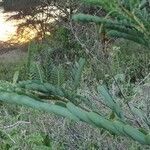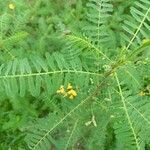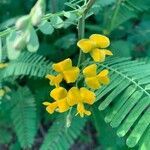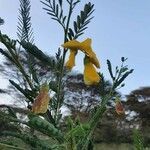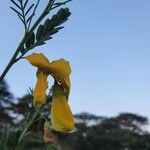Shrub or small short-lived tree 1-8 m tall with stem up to 12 cm in diameter. Stems sometimes tinged pinkish or bluish, laxly to densely spreading pubescent, sometimes glabrescent or, less often, almost totally glabrous. Leaves 2-18.5 cm long; rachis usually pubescent; petioles 0.3-1.6 cm long; leaflets in 6-27 pairs, 0.5-2.6 cm x 2-5.5 mm, oblong, obtuse to emarginate at apex, apiculate, glabrous or nearly so above, often pilose at the margins, midvein beneath usually pubescent, sometimes pubescent over the whole lower surface, occasionally densely so; stipules up to 7 mm long, narrowly triangular, usually inrolled or twisted, caducous or persistent, pubescent. Raceme (2)3-20-flowered, 2.8-14.5(19.7) cm long, glabrous or sparsely pilose; peduncle 1.4-4.4(5.7) cm long, glabrous or pubescent; pedicels 4-12 mm long, glabrous or less often sparsely pubescent; bracts and bracteoles (1)3-5 mm long, linear-lanceolate, ± glabrous or pilose, falling very early. Calyx 4-6.5 mm long (including receptacle), 4-8 mm wide, the tube glabrous; teeth 0.5-1 mm long, broadly triangular with a minute acuminate point, marginally pubescent. Standard uniformly yellow (sometimes with a pale green tinge) or more commonly speckled or flecked purplish on outer face, or sometimes suffused with purple, 1.1-2 cm long including a claw of 2.5-4 mm, 1.3-2.1 cm wide (up to 2.5 cm wide in West Africa), the blade 1¼-11/2 times as wide as long, widest below the middle, cordate at the base, appendages with acuminate free tips c.2-5 mm long; wings yellow, l.5-1.9 cm long including a claw of 4-6 mm, 4.5-7 mm wide, with a broad tooth or short hook at the base and lamellate sculpturing in the upper basal two-thirds; keel yellow or creamish sometimes tinged green, the blade 11-16 mm long including a claw of 6-9 mm, 6.5-9 mm wide, subtriangular with a broad, acute basal tooth at 0-20° to the claw. Ovary 30-50-ovulate, glabrous or rarely somewhat pilose along the upper suture or near the base of the style. Pod straw-coloured, often with a brown blotch over each septum, or reddish-brown, (3.7)15-28(31) cm x 2-5 mm, straight or slightly curved, sometimes slightly twisted, glabrous, (3)11-49-seeded; septa 4-8 mm apart; sutures cylindric, very rarely with swollen portions at intervals; valves sometimes fractured at right angles to the sutures. Seeds olive-green or brown, usually mottled dark purple or black, 3-4.5 x 2-2.25 mm, 2 mm thick, subcylindrical; hilum in a subcentral circular pit surrounded by an obscure rim aril.
More
Herbs, perennial, suffrutescent, 2-4 m tall. Branches pubescent, glabrescent, internodes often 0.5-2.5 cm, nodes conspicuously gibbous. Stipules triangular-lanceolate, 3-4 mm, caducous, pubescent. Leaves 20-40-foliolate; petiole and rachis appressed pubescent, more so at petiole base; rachis 4-10 cm; petiolules appressed pubescent; stipels acerose; leaflet blades oblong to linear, 1.3-2.5 cm × 3-4(-6) mm, both surfaces with purplish black glands, abaxially sparsely appressed pubescent when young but glabrescent, adaxially glabrous or glabrescent, midvein evident on both surfaces, base obliquely rounded, apex rounded to retuse and mucronate. Racemes 4-10-flowered; peduncle 8-10 cm, slender, pubescent, glabrescent; bracts linear-lanceolate, caducous, abaxially sparsely appressed pubescent. Pedicel ca. 8 mm, slender, pubescent when young; bracteoles smaller than bracts, caducous. Calyx campanulate; teeth shortly triangular, inside appressed pubescent to glabrescent. Corolla yellow or calyx and standard purplish black and wings and keel partly purplish black or red; standard transversely elliptic, 1.1-1.3 cm, wider than long, with a 4-5 mm claw, with a S-shaped callus ca. 2 mm, basally decurrent to lamina, widened in middle, and distinct and acuminate to obtuse at apex, base subcordate, apex emarginate; wings oblong, 1-1.2 cm, with a curved ca. 4 mm claw, base inconspicuously auriculate, apex rounded; keel nearly semicircular, 6-8 × 5-7 mm, lamina base narrower than apex and with a triangular short auricle, claw ± as long as calyx. Stamen tube 8-10 mm; anthers ellipsoid. Ovary glabrous; style ca. 5 mm, glabrous; stigma globose. Legume contorted when young but straight or slightly curved at maturity, subterete, 15-23(-30) cm × 3-4 mm, ca. 5 mm between transverse septa, base often with a marcescent calyx, apex beaked. Seeds 20-40 per legume, subterete, 3-4 × ca. 2 mm, slightly compressed; hilum rounded and concave. 2n = 12, 24.
A shrub. It grows to 6 m high. The bark is reddish-brown. The leaves are made up of 10-25 pairs of opposite leaflets. The leaflets are oblong. They can be 15 mm long by 3 mm wide. The flowers are yellow and pea shaped. The standard petal is often speckled with finely veined dark maroon. They occur in many flowered sprays. These are up to 15 cm long. The fruit are long slender pods. They are 30 cm long by 0.3 cm wide. They are often slightly curved.

